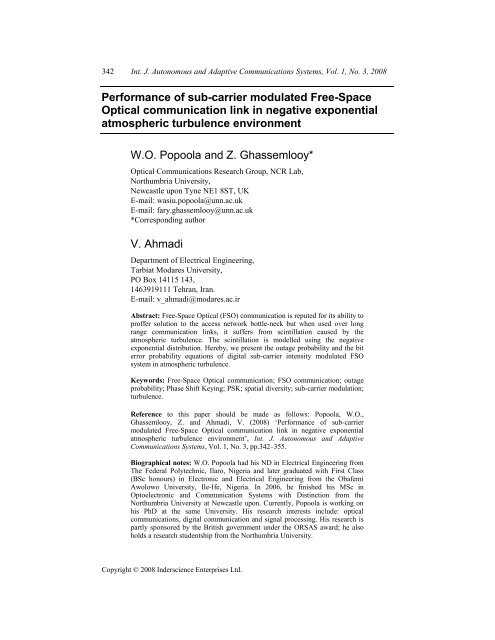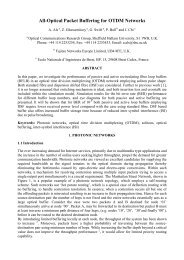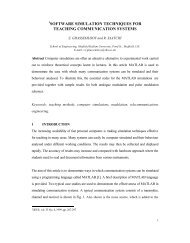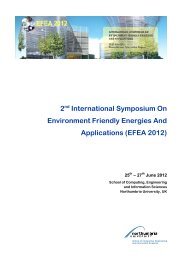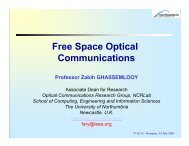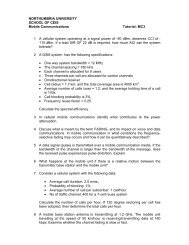Performance of sub-carrier modulated Free-Space Optical ...
Performance of sub-carrier modulated Free-Space Optical ...
Performance of sub-carrier modulated Free-Space Optical ...
You also want an ePaper? Increase the reach of your titles
YUMPU automatically turns print PDFs into web optimized ePapers that Google loves.
342 Int. J. Autonomous and Adaptive Communications Systems, Vol. 1, No. 3, 2008<br />
<strong>Performance</strong> <strong>of</strong> <strong>sub</strong>-<strong>carrier</strong> <strong>modulated</strong> <strong>Free</strong>-<strong>Space</strong><br />
<strong>Optical</strong> communication link in negative exponential<br />
atmospheric turbulence environment<br />
W.O. Popoola and Z. Ghassemlooy*<br />
<strong>Optical</strong> Communications Research Group, NCR Lab,<br />
Northumbria University,<br />
Newcastle upon Tyne NE1 8ST, UK<br />
E-mail: wasiu.popoola@unn.ac.uk<br />
E-mail: fary.ghassemlooy@unn.ac.uk<br />
*Corresponding author<br />
V. Ahmadi<br />
Department <strong>of</strong> Electrical Engineering,<br />
Tarbiat Modares University,<br />
PO Box 14115 143,<br />
1463919111 Tehran, Iran.<br />
E-mail: v_ahmadi@modares.ac.ir<br />
Abstract: <strong>Free</strong>-<strong>Space</strong> <strong>Optical</strong> (FSO) communication is reputed for its ability to<br />
pr<strong>of</strong>fer solution to the access network bottle-neck but when used over long<br />
range communication links, it suffers from scintillation caused by the<br />
atmospheric turbulence. The scintillation is modelled using the negative<br />
exponential distribution. Hereby, we present the outage probability and the bit<br />
error probability equations <strong>of</strong> digital <strong>sub</strong>-<strong>carrier</strong> intensity <strong>modulated</strong> FSO<br />
system in atmospheric turbulence.<br />
Keywords: <strong>Free</strong>-<strong>Space</strong> <strong>Optical</strong> communication; FSO communication; outage<br />
probability; Phase Shift Keying; PSK; spatial diversity; <strong>sub</strong>-<strong>carrier</strong> modulation;<br />
turbulence.<br />
Reference to this paper should be made as follows: Popoola, W.O.,<br />
Ghassemlooy, Z. and Ahmadi, V. (2008) ‘<strong>Performance</strong> <strong>of</strong> <strong>sub</strong>-<strong>carrier</strong><br />
<strong>modulated</strong> <strong>Free</strong>-<strong>Space</strong> <strong>Optical</strong> communication link in negative exponential<br />
atmospheric turbulence environment’, Int. J. Autonomous and Adaptive<br />
Communications Systems, Vol. 1, No. 3, pp.342–355.<br />
Biographical notes: W.O. Popoola had his ND in Electrical Engineering from<br />
The Federal Polytechnic, Ilaro, Nigeria and later graduated with First Class<br />
(BSc honours) in Electronic and Electrical Engineering from the Obafemi<br />
Awolowo University, Ile-Ife, Nigeria. In 2006, he finished his MSc in<br />
Optoelectronic and Communication Systems with Distinction from the<br />
Northumbria University at Newcastle upon. Currently, Popoola is working on<br />
his PhD at the same University. His research interests include: optical<br />
communications, digital communication and signal processing. His research is<br />
partly sponsored by the British government under the ORSAS award; he also<br />
holds a research studentship from the Northumbria University.<br />
Copyright © 2008 Inderscience Enterprises Ltd.
<strong>Performance</strong> <strong>of</strong> <strong>sub</strong>-<strong>carrier</strong> <strong>modulated</strong> FSO communication link 343<br />
Z. Ghassemlooy received his BSc in Electrical and Electronics Engineering<br />
from the Manchester Metropolitan University in 1981; an MSc and a PhD from<br />
the University <strong>of</strong> Manchester Institute <strong>of</strong> Science and Technology in 1984 and<br />
1987, respectively. From 1987 to 1988, he worked as a Post-Doctoral Research<br />
Fellow on optical sensors at the City University, London. He joined the<br />
Sheffield Hallam University as a Lecturer in 1988 and became a Pr<strong>of</strong>essor in<br />
1997. In 2004, he moved to the Northumbria University as an Associate Dean<br />
for research in the School <strong>of</strong> Computing, Engineering and Information<br />
Sciences. His research interests include: photonics networks, modulation<br />
techniques, high-speed optical systems, optical wireless communications and<br />
optical fibre sensors. He is a Chartered Engineer, a Fellow <strong>of</strong> IET and a Senior<br />
Member <strong>of</strong> IEEE.<br />
V. Ahmadi received his BSc in Electrical Engineering from the Sharif<br />
University <strong>of</strong> Technology, Tehran, Iran in 1985, and his MSc from the Tarbiat<br />
Modares University, Tehran, Iran in 1989, and his PhD from the Kyoto<br />
University, Kyoto, Japan in 1994 in Electronic Engineering–Optoelectronics.<br />
He joined the Tarbiat Modares University as an Assistant Pr<strong>of</strong>essor in 1994 and<br />
became a Pr<strong>of</strong>essor in 2006. He was the Head <strong>of</strong> the Semiconductor<br />
Department <strong>of</strong> Laser Research Centre, Tehran, Iran from 1994 to 2006. He<br />
became the Research Vice President <strong>of</strong> the Iran National Scientific Research<br />
Centre (1996–1997). His research interests include: quantum photonics devices,<br />
optical modulator and amplifiers, high-speed optical sources and detectors,<br />
optical microresonator active and passive devices, optical wireless<br />
communications and all optical switches.<br />
1 Introduction<br />
FSO communication systems as an alternative means <strong>of</strong> providing high bandwidth over a<br />
short to medium range links has seen a growing increase in research and development<br />
activities over the past few years. Increasing commercial deployment <strong>of</strong> the FSO could be<br />
said to be partly responsible for this surge in research activities (Willebrand and Ghuman,<br />
2002; Wilson et al., 2005). FSO is used in a number <strong>of</strong> applications including the cellular<br />
communication backhaul, optical fibre communications back-up links, exhibition halls<br />
and disaster recovery among other emerging applications (Willebrand and Ghuman,<br />
2002; Uysal, Li and Yu, 2006). However, <strong>of</strong> major concern in FSO systems is the<br />
dependence <strong>of</strong> its channel – the atmosphere – on the unpredictable weather conditions.<br />
Effects <strong>of</strong> fog, rain, atmospheric gases and aerosols result in beam attenuation due to<br />
photon absorption and scattering (Gagliardi and Karp, 1995).<br />
In dense fog conditions, laser radiations suffer prohibitive amount <strong>of</strong> attenuation<br />
limiting the FSO range to < 500 m in such conditions (Isaac, Kim and Korevaar, 2001).<br />
However, in clear atmosphere with low extinction coefficients, a longer range is easily<br />
achievable. In clear weather conditions, a primary factor that impairs the performance <strong>of</strong><br />
a FSO link is the random changes in atmospheric temperature. The temperature<br />
fluctuations depend on the speed <strong>of</strong> wind and the height above the ground <strong>of</strong> the<br />
traversing laser radiation (Osche, 2002).The resulting eddies/cells <strong>of</strong> varying sizes (from<br />
~0.1 to ~10 m) act like refractive prisms <strong>of</strong> varying index <strong>of</strong> refraction (Killinger, 2002).<br />
Consequently, a laser radiation traversing a turbulence atmosphere experiences random<br />
variation (fading) in its irradiance and phase. A familiar effect <strong>of</strong> turbulence is the
344 W.O. Popoola Z. Ghassemlooy and V. Ahmadi<br />
twinkling <strong>of</strong> stars caused by random fluctuations <strong>of</strong> stars’ irradiance. The shimmer <strong>of</strong> the<br />
horizon on a hot day is another effect, this time caused by random changes in the optical<br />
phase <strong>of</strong> the light beam resulting in the reduced image resolution (Killinger, 2002).<br />
Techniques reported in literature to mitigate fading effect include forward error control<br />
(Simon and Vilnrotter, 2005; Uysal, Li and Yu, 2006) spatial and temporal diversity (Zhu<br />
and Kahn, 2002; Lee and Chan, 2004; Navidpour, Uysal and Jing, 2004) aperture<br />
averaging and adaptive optics (Elon Grave and Drenker, 2002; Kedar and Arnon, 2004;<br />
Razavi and Shapiro, 2005).<br />
The most reported modulation technique used for FSO is the On–Off Keying (OOK),<br />
but recently <strong>sub</strong>-<strong>carrier</strong> modulation has been attracting increased interest. The idea <strong>of</strong><br />
<strong>sub</strong>-<strong>carrier</strong> modulation is borrowed from the widely used multiple <strong>carrier</strong> radio<br />
communication (e.g. OFDM systems). In optical fibre communication networks, this <strong>sub</strong><strong>carrier</strong><br />
modulation techniques has been commercially adopted in transmitting cable<br />
television signals and has also been used in conjunction with wavelength division<br />
multiplexing (Agrawal, 2002). For the seamless integration <strong>of</strong> FSO systems into today<br />
and future networks, which already comprise <strong>of</strong> <strong>sub</strong>-<strong>carrier</strong> <strong>modulated</strong> (or multiple<br />
<strong>carrier</strong>) signals, the study <strong>of</strong> <strong>sub</strong>-<strong>carrier</strong> <strong>modulated</strong> FSO is thus imperative. Other reasons<br />
for carrying out research in Sub-<strong>carrier</strong> Intensity Modulated (SIM) FSO systems include:<br />
1 It leverages on the already developed and evolved Radio Frequency (RF)<br />
communication components such as stable oscillators and narrow filters (Rongqing<br />
et al., 2002).<br />
2 It avoids the need for adaptive threshold required by optimum performing OOK<br />
<strong>modulated</strong> FSO (Popoola, Ghassemlooy and Leitgeb, 2007b).<br />
3 Can be used to increase capacity by accommodating data from different users on<br />
different <strong>sub</strong>-<strong>carrier</strong>s.<br />
The performance <strong>of</strong> SIM in certain atmospheric turbulence conditions have been reported<br />
in the literature. For example, Huang et al. (1993) and Popoola, Ghassemlooy and<br />
Leitgeb (2007a) reported SIM in log normal modelled weak atmospheric turbulence.<br />
Others include the performance <strong>of</strong> SIM in weak to strong turbulence (Popoola,<br />
Ghassemlooy and Leitgeb, 2007b) employing the gamma–gamma turbulence model<br />
proposed by Andrews, Phillips and Hopen (2001). The negative exponential turbulence<br />
model is widely accepted and experimentally verified to be suitable in the limit <strong>of</strong> strong<br />
turbulence, (i.e. during saturation regime and beyond). The performance <strong>of</strong> the OOK and<br />
pulse position <strong>modulated</strong> FSO links have both been investigated in the limit <strong>of</strong> strong<br />
turbulence using the negative exponential model (Wilson et al., 2005; Garcia-Zambrana,<br />
2007) but not the SIM. Therefore, we present in this article SIM FSO with the spatial<br />
diversity in negative exponential turbulence. The spatial diversity scheme is<br />
advantageous in combating temporary link blockage by birds and misalignment when<br />
combined with a wide laser beamwidth, thereby eliminating the need for active tracking.<br />
It is also much easier to provide independent aperture averaging with the multiple<br />
separate aperture system, than in a single aperture where the aperture size has to be far<br />
greater than the irradiance spatial coherence distance (Lee and Chan, 2004). The article is<br />
arranged as follows: FSO system is briefly described in Section 2, <strong>sub</strong>-<strong>carrier</strong> modulation<br />
in Section 3 while performance metrics and conclusion are given in Sections 4 and 5,<br />
respectively.
<strong>Performance</strong> <strong>of</strong> <strong>sub</strong>-<strong>carrier</strong> <strong>modulated</strong> FSO communication link 345<br />
2 FSO system description<br />
FSO like most communication systems has the following three functional elements.<br />
2.1 The transmitter<br />
This functional element has the primary function <strong>of</strong> converting the source information<br />
into optical radiation which is then propagated through the atmosphere to the receiver.<br />
The essential components <strong>of</strong> the transmitter are: the modulator in this case Phase Shift<br />
Keying (PSK) modulator; the driver circuit for the optical source, which also helps<br />
stabilise the optical radiation against temperature fluctuations and component ageing; the<br />
optical source with direct intensity modulation, where the radiation intensity/irradiance is<br />
proportional to the modulating signal (Gagliardi and Karp, 1995) the transmitter<br />
telescope which collects, collimates and directs the optical radiation towards the receiver<br />
telescope via the atmospheric channel.<br />
2.2 Atmospheric channel<br />
The optical radiation traversing the atmosphere suffers mainly from absorption, scattering<br />
and atmospheric turbulence. These effects are caused by the constituents <strong>of</strong> the<br />
atmosphere (aerosols, gases, smoke, etc.) and the weather effects (fog, haze, temperature<br />
fluctuations, etc.). The atmospheric channel might be the terrestrial distance traversed by<br />
the optical radiation as is the case in this work or the distance between a ground station<br />
and a satellite. The most deleterious <strong>of</strong> all is the thick fog. This can cause attenuation<br />
>200 dB km –1 (Bloom et al., 2003) thereby placing a fundamental limit on the achievable<br />
link range (1 km, the atmospheric<br />
turbulence becomes the prevailing source <strong>of</strong> FSO performance degradation and is the<br />
effect considered in this work.<br />
Solar radiation absorbed by the earth surface causes air around the earth surface to be<br />
warmer than those above them. This sheet <strong>of</strong> warmer air becomes less dense and rises to<br />
mix turbulently with the surrounding cooler air causing the air temperature to fluctuate<br />
randomly (Pratt, 1969). These temperature fluctuations are a function <strong>of</strong> altitude,<br />
atmospheric pressure and wind speed (Zhu and Kahn, 2002). This inhomogeneities<br />
caused by turbulence can be viewed as discrete cells <strong>of</strong> different temperature acting like<br />
refractive prisms <strong>of</strong> different indices <strong>of</strong> refraction. Then, they refract/scatter (depending<br />
on the relative size <strong>of</strong> the optical radiation) an optical radiation traversing the medium<br />
resulting in random irradiance and phase variations. Detailed study <strong>of</strong> atmospheric<br />
turbulence can be found in (Pratt, 1969; Goodman, 1985; Andrews, Phillips and Hopen,<br />
2001; Osche, 2002; Zhu and Kahn, 2002). In this work, the negative exponential model is<br />
considered with irradiation Probability Density Function (PDF) given by (1).<br />
2.2.1 Negative exponential model<br />
In the limit <strong>of</strong> strong irradiance fluctuations, (i.e. in the saturation regime and beyond)<br />
where link length spans several kilometres, the number <strong>of</strong> independent scatterings<br />
becomes large (Karp et al., 1988). The amplitude fluctuation <strong>of</strong> the field traversing the
346 W.O. Popoola Z. Ghassemlooy and V. Ahmadi<br />
turbulent medium in this situation is generally believed and experimentally verified to<br />
obey the Rayleigh distribution implying negative exponential statistics for the irradiance<br />
(Karp et al., 1988). That is:<br />
1 I<br />
<br />
pI ( ) exp , I0<br />
I I<br />
o<br />
o (1)<br />
where I o = E[I] is the mean irradiance. An important parameter for describing the strength<br />
<strong>of</strong> turbulence is the log intensity variance <br />
2 1<br />
. The Scintillation Index (S.I.) given by<br />
2 2<br />
SI .. { EI [ ]/( EI [])} 1 is another important parameter for describing turbulence<br />
strength. In fact, it is the log intensity variance normalised by the square <strong>of</strong> the mean<br />
irradiance. S.I. is sometimes referred to as ‘amount <strong>of</strong> turbulence induced fading’. For the<br />
turbulence model under consideration S.I.1. It should be noted that other turbulence<br />
models such as the log-normal-Rician distribution and the I–K which are both valid from<br />
weak to strong turbulence regime; the K-model – valid only for the strong regime and the<br />
gamma–gamma turbulence models which is reported to cover all regimes from weak to<br />
the saturation all reduce to the negative exponential in the limit <strong>of</strong> strong turbulence<br />
(Karp et al., 1988).<br />
2.3 Receiver<br />
This encompasses:<br />
1 The receiver telescope which essentially collects and focuses the incoming optical<br />
radiation on to the photodetector. (A large receiver telescope aperture is<br />
advantageous as it collects verse uncorrelated radiations and focuses their average on<br />
the photodetector. This is referred to as aperture averaging but a wide aperture also<br />
means more background radiation (noise)).<br />
2 An optical band-pass filter to reduce the background radiations.<br />
3 A photodetector.<br />
4 An amplifier.<br />
5 A decision circuit.<br />
Since, the atmospheric effects that significantly degrade FSO performance are known to<br />
be wavelength independent (Isaac, Kim and Korevaar, 2001). Therefore, FSO uses the<br />
same wavelength as optical fibre communications to leverage on the availability and<br />
maturity <strong>of</strong> devices at such wavelengths (785, 850 and 1,550 nm). In Manor and Arnon<br />
(2003), it is reported that improved availability can be achieved at 10 µm wavelength but<br />
at the very high cost <strong>of</strong> devices.
<strong>Performance</strong> <strong>of</strong> <strong>sub</strong>-<strong>carrier</strong> <strong>modulated</strong> FSO communication link 347<br />
Figure 1<br />
FSO employing BPSK <strong>modulated</strong> SIM block diagram (a) transmitter and (b) receiver<br />
TIP-Trans-Impedance Amplifier; TT-Transmit Telescope and RT-Receive Telescope.<br />
3 Sub-<strong>carrier</strong> modulation<br />
In optical SIM, an RF signal (<strong>sub</strong>-<strong>carrier</strong>) pre-<strong>modulated</strong> with the source data is used to<br />
modulate the intensity <strong>of</strong> an optical <strong>carrier</strong>. SIM is considered because it does not need<br />
adaptive threshold to perform optimally (Popoola, Ghassemlooy and Leitgeb, 2007b), it<br />
is resilient to the irradiance fluctuation and can be easily de<strong>modulated</strong> coherently by<br />
using well evolved low phase noise RF oscillator (Rongqing et al., 2002). Figure 1 shows<br />
the block diagram <strong>of</strong> SIM FSO system. Prior to modulating the laser irradiance, the <strong>sub</strong><strong>carrier</strong><br />
signal is pre-<strong>modulated</strong> with the source data d(t) using PSK. The <strong>sub</strong>-<strong>carrier</strong> signal<br />
m(t) is DC-level shifted to ensure that the bias current is always equal to or greater than<br />
the threshold current. Direct detection is employed at the receiver and the instantaneous<br />
photocurrent <strong>of</strong> the PIN photodetector is modelled as:<br />
i r () t RI (1 <br />
m ()) t n () t<br />
(2)<br />
where I = I peak /2, Ipeak is the peak received irradiance, is the modulation index and R is<br />
the photodetector responsivity. Over a symbol duration, the <strong>sub</strong>-<strong>carrier</strong> signal is given by
348 W.O. Popoola Z. Ghassemlooy and V. Ahmadi<br />
m(t) = Ag(t) cos( c t + ), where g(t) represents the rectangular pulse shaping function, c<br />
and A are the <strong>sub</strong>-<strong>carrier</strong> signal frequency and amplitude, respectively, and n(t)~N(0, 2 ) is<br />
the additive white Gaussian noise. is chosen to keep the optical transmitter within its<br />
dynamic range; in order to avoid clipping/over-modulation the condition m(t) 1 must<br />
be met at all times. An estimate <strong>of</strong> the absolute phase <strong>of</strong> the RF <strong>sub</strong>-<strong>carrier</strong> signal is then<br />
extracted from the photocurrent for <strong>sub</strong>sequent coherent demodulation in order to recover<br />
the source data estimate dt ˆ( ). In some cases, the phase extraction might be very<br />
demanding; in such situations Differential PSK (DPSK) should be adopted. It is also<br />
possible to increase the system capacity by modulating different source data onto<br />
different RF <strong>sub</strong>-<strong>carrier</strong> frequencies. The composite RF signal can then be used to<br />
modulate the irradiance <strong>of</strong> the optical source resulting in multiple SIM. Though,<br />
increased capacity is achieved but at a cost <strong>of</strong> increased transmitted optical power and<br />
inter-modulation distortion. The analysis and performance <strong>of</strong> multiple SIM is outside the<br />
scope <strong>of</strong> this article.<br />
4 <strong>Performance</strong> metric<br />
<strong>Performance</strong> metrics are used to characterise, model and predict the behaviour <strong>of</strong> a<br />
system. In atmospheric turbulence, the popular performance metrics for FSO are: the<br />
outage probability which is a measure <strong>of</strong> the probability that the instantaneous Bit Error<br />
Rate (BER) is greater that a pre-determined threshold level, and the generic BER metric<br />
which models the fraction <strong>of</strong> bits received incorrectly in a digital communication system.<br />
In the following sections, we present and discuss the BER <strong>of</strong> BPSK <strong>modulated</strong> SIM FSO<br />
with and without spatial diversity.<br />
4.1 Bit error rate<br />
For an M-PSK <strong>modulated</strong> SIM optical communication link with atmospheric turbulence,<br />
where the Channel State Information (CSI) is unknown by the receiver, the BER is<br />
obtained by averaging the BER <strong>of</strong> the M-ary PSK <strong>modulated</strong> RF <strong>sub</strong>-<strong>carrier</strong> signal over<br />
the atmospheric turbulence statistics. For a Binary PSK (BPSK) <strong>modulated</strong> <strong>sub</strong>-<strong>carrier</strong>,<br />
this unconditional BER is given by:<br />
P Q( ) p( I)dI I 0<br />
e<br />
<br />
<br />
0<br />
(3)<br />
where p(I) is the PDF <strong>of</strong> the received irradiance given by (1) for a negative exponential<br />
2 2<br />
distributed turbulence, Qx ( ) 0.5erfc( x/ 2) and =(RAI) /2 is the electrical Signalto-Noise<br />
Ratio (SNRe) per bit at the input <strong>of</strong> the coherent demodulator. For DPSK based<br />
SIM, the BER expression is as given in (Popoola, Ghassemlooy and Leitgeb, 2007a). By<br />
<strong>sub</strong>stituting (1) into (3) and changing the order <strong>of</strong> integration, we easily obtain the<br />
following expression for the BER:<br />
/2<br />
2<br />
1 I I <br />
Pe<br />
exp<br />
dI<br />
d<br />
I <br />
<br />
<br />
4 K( )<br />
I <br />
(4)<br />
<br />
<br />
0 0
<strong>Performance</strong> <strong>of</strong> <strong>sub</strong>-<strong>carrier</strong> <strong>modulated</strong> FSO communication link 349<br />
where K() = 2 sin 2 /R 2 A 2 .<br />
Invoking the relation (3.322.2) given in Gradshteyn and Ryzhik (1994) and assuming<br />
that E[I] = I o = 1, the unconditional BER reduces to:<br />
/2<br />
1<br />
Pe<br />
K( )exp( K( ))erfc K( ))d .<br />
<br />
(5)<br />
0<br />
This expression above has no closed form and can thus be evaluated using numerical<br />
integration. However, an upper bound can be obtained for it by making = /2, this<br />
maximises the integrand resulting in the expression below:<br />
Pe K exp( K) Q( 2 K)<br />
(6)<br />
where K = 2 / R 2 A 2 .<br />
4.1.1 Equal gain combining spatial diversity<br />
In order to mitigate scintillation effect and temporary blocking caused by birds we<br />
consider the use <strong>of</strong> receiver array. The use <strong>of</strong> photodetector array also makes it easier to<br />
achieve aperture averaging compared to using a single photodetector <strong>of</strong> the same area as<br />
the combined array <strong>of</strong> photodetectors. The output <strong>of</strong> each photodetector in the array is<br />
scaled by a unity weighting factor, (i.e. in Figure 2). The outputs are co-phased and then<br />
combined; this approach is referred to as the Equal Gain Combining (EGC) in the<br />
literature.<br />
Figure 2<br />
Spatial diversity receiver with N-photodetectors<br />
The spatial diversity is premised on the spacing <strong>of</strong> the photodetectors being greater than<br />
the optical radiation transverse coherence distance. This is to guarantee uncorrelated<br />
received irradiance so that the N-photodetectors do not all experience deep irradiance<br />
fades at the same time. To facilitate a fair comparison between single-transmitter–single-
350 W.O. Popoola Z. Ghassemlooy and V. Ahmadi<br />
receiver-system and spatial diversity system, each pupil area in the N-photodetector<br />
system is assumed to be A D /N, where A D is the detector area under single transmitter–<br />
single receiver link. Therefore, it follows that the background radiation noise ni<br />
i<br />
1<br />
on<br />
each link with detector diversity is also reduced by a factor N from that with no spatial<br />
diversity resulting in n N<br />
2<br />
i N (0, / )<br />
i 1<br />
i N . By assuming identical PIN diode detectors on<br />
<br />
each link, the combiner output photocurrent with suppressed DC component is given by:<br />
<br />
N R<br />
<br />
iT<br />
I (1 Ag()cos(<br />
1<br />
i t ct )) n()<br />
t<br />
i<br />
<br />
N<br />
<br />
<br />
<br />
where = [0, ]. The SNRe at the output <strong>of</strong> the EGC combiner conditioned on the<br />
received signal intensity can be derived as:<br />
RA <br />
2 N<br />
2<br />
I<br />
2<br />
i 1<br />
i<br />
N<br />
<br />
<br />
EGC <br />
2<br />
.<br />
<br />
N<br />
<br />
<br />
Assuming Z I<br />
i1<br />
i<br />
where the negative exponential distributed random variable I i is<br />
the irradiance received by the ith photodetector. For independent and identically<br />
distributed irradiance, the PDF <strong>of</strong> Z given by (9) and plotted in Figure 3 is quite straight<br />
forward; it is obtained by taking the inverse Fourier transform <strong>of</strong> the N-fold product <strong>of</strong><br />
the characteristic function <strong>of</strong> I, with I o normalised to unity.<br />
N <br />
Z<br />
1 exp( Z)<br />
pZ ( ) <br />
, Z0.<br />
( N)<br />
Without CSI, the unconditional BER is thus given by:<br />
N<br />
(7)<br />
(8)<br />
(9)<br />
P Q( ) p( Z)dZ<br />
e<br />
<br />
<br />
0<br />
EGC<br />
/2<br />
1<br />
N 1 2<br />
Z exp( K1( ) Z Z)dZd<br />
( N)<br />
<br />
0 0<br />
(10)<br />
where K() = R 2 A 2 / 4 2 N 2 sin 2 (). The expression has no known closed form.<br />
Employing equation (3.462) in (Gradshteyn and Ryzhik, 1994) and the approached used<br />
in Section 4.1, an upper bound is obtained as:<br />
N<br />
/2<br />
(2 K1)<br />
e 1<br />
P exp(1/ 8 K ) D<br />
N (1/ 2 K)<br />
(11)<br />
2<br />
where D n is the parabolic cylinder function (Gradshteyn and Ryzhik, 1994).<br />
4.2 Outage probability, P o<br />
The outage probability is another metric for characterising the performance <strong>of</strong> digital<br />
communication systems in fading channels. This metric measures the probability that the
<strong>Performance</strong> <strong>of</strong> <strong>sub</strong>-<strong>carrier</strong> <strong>modulated</strong> FSO communication link 351<br />
BER <strong>of</strong> the systems is greater than a pre-defined threshold value. This is akin to<br />
evaluating the probability that the instantaneous SNR e is lower than a threshold * . SNR e<br />
Unlike the average BER which does not necessarily reflect the effect <strong>of</strong> fading at every<br />
instant, the outage probability reflects this as it compares the instantaneous SNR e with a<br />
threshold value. It should be stressed that the irradiance fading experienced in FSO is<br />
turbulence induced unlike the multipath induced fading that characterises RF wireless<br />
communication.<br />
*<br />
e e<br />
P p(BER>BER*) p(SNR SNR ).<br />
(12)<br />
Figure 3<br />
The PDF <strong>of</strong> sum <strong>of</strong> negative exponential varying irradiance<br />
*<br />
Assume SNR e<br />
to be the SNR e in the absence <strong>of</strong> irradiance fluctuation and by introducing<br />
a variable m as the additional power needed to achieve outage probability P o , the<br />
following expression is obtained:<br />
Io<br />
/ m<br />
<br />
<br />
0<br />
P pI ( I / m) pI ( )d I.<br />
From (5) and (13), the power margin m can thus be obtained as:<br />
(13)<br />
1<br />
[ 1n(1 )] .<br />
(14)<br />
m P <br />
With EGC spatial diversity, the outage probability P o = p ( EGC < *), is obtained by<br />
introducing a parameter m EGC defined as the amount <strong>of</strong> additional irradiance needed on<br />
each branch <strong>of</strong> the N-photodetector array to achieve an outage probability P o ; this results<br />
in the following:<br />
<br />
<br />
mEGC<br />
N <br />
P p<br />
I<br />
1<br />
i I p( Z IN / mEGC<br />
).<br />
N<br />
<br />
i<br />
<br />
<br />
<br />
(15)
352 W.O. Popoola Z. Ghassemlooy and V. Ahmadi<br />
This expression denotes the cumulative distribution function <strong>of</strong> Z at the specified point;<br />
combining with (9), the outage probability is derived as:<br />
o<br />
N/<br />
mEGC<br />
<br />
P p( Z)dZ<br />
0<br />
N/<br />
mEGC<br />
<br />
N 1<br />
Z exp( Z) / ( N)d Z.<br />
0<br />
(16)<br />
Equation (16) can be expressed as in implicit function in terms <strong>of</strong> the incomplete gamma<br />
function (a, x) (Gradshteyn and Ryzhik, 1994) or as a series, that is:<br />
P<br />
( N, N / mEGC<br />
)/ ( N)<br />
k Nk<br />
1 ( 1) ( N / mEGC<br />
)<br />
( N) k 0<br />
k!( N k)<br />
(17)<br />
a1<br />
where ( ax , )= exp( tt ) d t.<br />
x<br />
<br />
0<br />
4.3 Results and discussion<br />
A plot <strong>of</strong> the exact BER obtained via numerical integration <strong>of</strong> (5) and the upper bound<br />
given by (6) against the normalised SNR = (E[I]R) 2 / 2 for a number photodetectors used<br />
are presented in Figure 4. The upper bound is not very tight as seen from the figure. It<br />
lags behind the exact BER curve by about 4 dB mainly due to the approximation carried<br />
out in arriving at the upper bound expression. From the figure, it is evident that an<br />
unmitigated scintillation results in SNR > 55 dB to attain an unconditional BER that is<br />
less than 10 –3 . The figure also reveals that the gain improvement in the SNR when using<br />
more than one photodetector particularly at low values <strong>of</strong> BER.<br />
Figure 4<br />
BER against the SNR <strong>of</strong> BPSK SIM FSO in negative exponential atmospheric<br />
turbulence
<strong>Performance</strong> <strong>of</strong> <strong>sub</strong>-<strong>carrier</strong> <strong>modulated</strong> FSO communication link 353<br />
Figure 5<br />
The outage probability against the power margin, m (dBm) for 1, 2 and 4 photodetectors<br />
using EGC diversity<br />
Figure 6 Diversity gain against number <strong>of</strong> independent photodetectors at BER and P o <strong>of</strong> 10 –6<br />
Figure 5 shows the extra power margin required to achieve a certain outage probability P o<br />
with and without spatial diversity. The gain <strong>of</strong> employing diversity is quite apparent from<br />
the figure just as in the case under the BER performance metric. For instance at P o <strong>of</strong><br />
10 6 , a diversity gain <strong>of</strong> nearly 30 dB is predicted and this increases to about 43 dB with<br />
four photodetectors. This significant gain is down to the fact that with multiple<br />
photodetectors, more independent irradiances are received. In the case <strong>of</strong> a single<br />
photodetector with an aperture size same as that <strong>of</strong> N-photodetectors combined, the<br />
increased noise level from background sources tends to cancel out any potential gain<br />
from aperture averaging that large aperture area pr<strong>of</strong>fers.<br />
To further elucidate the gain <strong>of</strong> employing spatial diversity for FSO in atmospheric<br />
turbulence, we show in Figure 6 the predicted diversity gain (ratio <strong>of</strong> SNR or m with one
354 W.O. Popoola Z. Ghassemlooy and V. Ahmadi<br />
photodetector to that <strong>of</strong> N-photodetectors at the specified BER or P o ) as a function <strong>of</strong> the<br />
number <strong>of</strong> photodetector N. As the number <strong>of</strong> photodetectors increases, the diversity gain<br />
plateaus.<br />
It should be noted that both P o and BER are different by definition; but they both<br />
resulted in the similar inferences as seen in Figure 6. However, it should be motioned that<br />
using an array <strong>of</strong> photodetectors adds to the cost and design complexity.<br />
5 Conclusions<br />
In this article, we presented the performance <strong>of</strong> SIM FSO in negative exponential<br />
atmospheric turbulence. The outage probability and BER expressions have been<br />
presented as well as an expression for the BER upper bound. We equally derived<br />
expressions for the stated metrics with photodetector array as way <strong>of</strong> ameliorating<br />
scintillation effect. The gain in power from the adoption <strong>of</strong> photodetector array has also<br />
been presented. A diversity gain <strong>of</strong> ~50 dB is predicted at BER <strong>of</strong> 10 –6 with just two<br />
independent PIN photodetectors in fully developed speckle. And as more photodetectors<br />
are added, the diversity gain value tends toward an asymptotic value. Although, P o and<br />
BER are different metrics by definition but they resulted in similar inferences.<br />
References<br />
Agrawal, G.P. (2002) Fiber-optic Communication Systems. New York, NY: Wiley-Interscience.<br />
Andrews, L.C., Phillips, R.L. and Hopen, C.Y. (2001) Laser Beam Scintillation with Applications.<br />
Bellingham, WA: SPIE.<br />
Bloom, S., Korevaar, E., Schuster, J. and Willebrand, H. (2003) ‘Understanding the performance <strong>of</strong><br />
free-space optics’, Journal <strong>of</strong> <strong>Optical</strong> Networking, Vol. 2, pp.178–200.<br />
Elon Grave, J. and Drenker, S. (2002) ‘Advancing free space optical communication with adaptive<br />
optics’, Lightwave, Vol. 19, pp.105–113.<br />
Gagliardi, R.M. and Karp, S. (1995) <strong>Optical</strong> Communications. New York, NY: John Wiley.<br />
Garcia-Zambrana, A. (2007) ‘Error rate performance for STBC in free-space optical<br />
communications through strong atmospheric turbulence’, IEEE Communication Letters,<br />
Vol. 11, pp.390–392.<br />
Goodman, J.W. (1985) Statistical Optics. New York, NY: John Wiley.<br />
Gradshteyn, I.S. and Ryzhik, I.M. (1994) Table <strong>of</strong> Integrals, Series, and Products. London, UK:<br />
Academic Press, Inc.<br />
Huang, W., Takayanagi, J., Sakanaka, T. and Nakagawa, M. (May 1993) ‘Atmospheric optical<br />
communication system using <strong>sub</strong><strong>carrier</strong> PSK modulation’, ICC 93, IEEE International<br />
Conference on Communications, Vol. 3, pp.1597–1601 (Geneva).<br />
Isaac, I., Kim, B.M. and Korevaar, E. (2001) ‘Comparison <strong>of</strong> laser beam propagation at 785 nm and<br />
1550 nm in fog and haze for optical wireless communications’, SPIE Proceeding: <strong>Optical</strong><br />
Wireless Communications III, Vol. 4214, pp.26–37.<br />
Karp, S., Gagliardi, R.M., Moran, S.E. and Stotts, L.B. (1988) <strong>Optical</strong> Channels: Fibers, Cluds,<br />
Water and the Atmosphere. New York, NY: Plenum Press.<br />
Kedar, D. and Arnon, S. (May, 2004) ‘Urban optical wireless communication networks: the main<br />
challenges and possible solutions’, IEEE <strong>Optical</strong> Communications, Vol. 42, pp.s2–s7.<br />
Killinger, D. (2002) ‘<strong>Free</strong> space optics for laser communication through the air’, Optics and<br />
Photonics News, Vol. 13, pp.36–42.
<strong>Performance</strong> <strong>of</strong> <strong>sub</strong>-<strong>carrier</strong> <strong>modulated</strong> FSO communication link 355<br />
Lee, E.J. and Chan, V.W.S. (2004) ‘<strong>Optical</strong> communications over the clear turbulent channel using<br />
diversity’, IEEE Journal on Selected Areas in Communications, Vol. 22, pp.1896–1906.<br />
Manor, H. and Arnon, S. (July, 2003) ‘<strong>Performance</strong> <strong>of</strong> an optical wireless communication system<br />
as a function <strong>of</strong> wavelength’, Applied Optics, Vol. 42, pp.4285–4294.<br />
Navidpour, S.M., Uysal, M. and Jing, L. (2004) ‘BER performance <strong>of</strong> MIMO free-space optical<br />
links’, 60th IEEE Vehicular Technology Conference, Vol. 5, pp.3378–3382.<br />
Osche, G.R. (2002) <strong>Optical</strong> Detection Theory for Laser Applications. Hoboken, New Jersey:<br />
Wiley.<br />
Popoola, W.O., Ghassemlooy, Z. and Leitgeb, E. (2007a) ‘<strong>Free</strong>-space optical communication in<br />
atmospheric turbulence using DPSK <strong>sub</strong><strong>carrier</strong> modulation’, Ninth International Symposium<br />
on Communication Theory and Applications ISCTA'07, Ambleside, Lake District, UK.<br />
Popoola, W.O., Ghassemlooy, Z. and Leitgeb, E. (2007b) ‘<strong>Free</strong>-space optical communication using<br />
<strong>sub</strong><strong>carrier</strong> modulation in gamma-gamma atmospheric turbulence’, 9th International<br />
Conference on Transparent <strong>Optical</strong> Networks (ICTON '07), Vol. 3, pp.156–160, Rome Italy.<br />
Pratt, W.K. (1969) Laser Communication Systems. New York, NY: John Wiley and Sons, Inc.<br />
Razavi, M. and Shapiro, J.H. (May, 2005) ‘Wireless optical communications via diversity reception<br />
and optical preamplification’, IEEE Transaction on Communications, Vol. 4, pp.975–983.<br />
Rongqing, H., Benyuan, Z., Renxiang, H., Christopher, T.A., Kenneth, R.D. and Douglas, R.<br />
(2002) ‘Sub<strong>carrier</strong> multiplexing for high-speed optical transmission’, Journal <strong>of</strong> Lightwave<br />
Technology, Vol. 20, pp.417–424.<br />
Simon, M.K. and Vilnrotter, V.A. (Jan., 2005) ‘Alamouti-type space-time coding for free space<br />
optical communication with direct detection’, IEEE Transaction on Communications, Vol. 4,<br />
pp.35–39.<br />
Uysal, M., Li, J.T. and Yu, M. (2006) ‘Error rate performance analysis <strong>of</strong> coded free-space optical<br />
links over gamma-gamma atmospheric turbulence channels’, IEEE Transactions on Wireless<br />
Communications, Vol. 5, pp.1229–1233.<br />
Willebrand, H. and Ghuman, B.S. (2002) <strong>Free</strong> <strong>Space</strong> Optics: Enabling <strong>Optical</strong> Connectivity in<br />
Today’s Network. Indianapolis, IN: SAMS publishing.<br />
Wilson, S.G., Brandt-Pearce, M., Cao, Q. and Leveque, J.H. (2005) ‘<strong>Free</strong>-space optical MIMO<br />
transmission with Q-ary PPM’, IEEE Transactions on Communications, Vol. 53,<br />
pp.1402–1412.<br />
Zhu, X. and Kahn, J.M. (2002) ‘<strong>Free</strong>-space optical communication through atmospheric turbulence<br />
channels’, IEEE Transactions on Communications, Vol. 50, pp.1293–1300.


